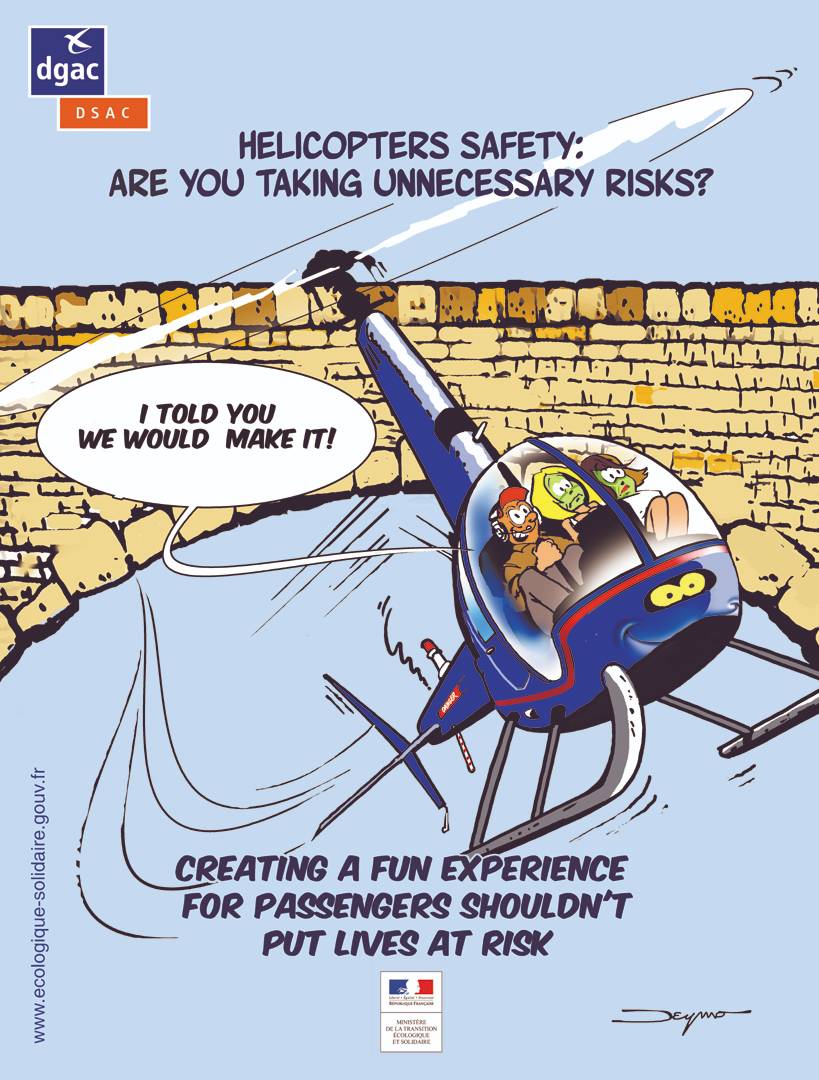Some video clips on the Internet show helicopter pilots performing risky manoeuvres like abrupt turns and dives, extreme wingovers, low flying over highways and open roads in mountainous areas, flying at high speed close to cliffs and in narrow valleys, flying under bridges, etc. In this article you will be encouraged to flying safely and avoid this type of behaviour.
Some of these manoeuvres are forbidden by national and European law: check out the Standardised European Rules of the Air (SERA). The pilot could also be breaking Certification limits and Flight Standards and Operations regulations. Any of which could lead to prosecution or loss of a job.

Aerobatic manoeuvres and certification limits
Aerobatic manoeuvres should only be performed by trained aerobatic-rated pilots on appropriately certified aircraft. Furthermore, non-aerobatic manoeuvres near the edge of the flight envelope aren’t necessarily safe. Even within certification limits they put mechanical strain on the rotorcraft structure. Particularly the main rotor system with gearboxes, main transmission, the tail rotor system and the engine are affected.
Mechanical stress can lead to mechanical fatigue. While the helicopter might not show any damage at the time, it is a later mission where a potentially fatal failure may show up. As noted by a retired Air Force pilot, many Hueys had mast bumping and it was later trip on which the shaft failed. CH47 and S-61 for instance had a strain gauge / cruise guide indicator, which gave a very good indication of the strain put through the transmission.
An example from an Accident Report
This Accident Report gives details of the loss of a Bell 412 where military pilots were inadvertently exceeding the sloping ground limits of the aircraft. Most military versions of civilian helicopters have absolute limits on bank and pitch placed on them by the certifying authorities. Whereas pure civilian versions may not have definitive limits for bank and pitch and just state ‘no aerobatic manoeuvres’ in the pilot notes. In summary it is not you that a fatigue failure or exceedance may kill, but a following pilot and passengers.
Human factors aspects
Abrupt manoeuvres can also induce somatographic illusions and other physiological reactions such as nausea and stress. Acceleration, deceleration and aircraft behaviour can also take pilots by surprise and ‘startle and surprise’ effect can substantially downgrade performance, if not properly managed. Are you really sure that any accompanying passengers and crew are happy with what you are doing? Is it worth putting yourself and others at risk? Absolutely not!
The following safety tips could save your life and the lives of others!
- Always operate the helicopter within its certification, flight envelope and operational limits. Only fly legal flights - things that are forbidden are forbidden for a good reason.
- Just as importantly always operate the helicopter within you own limits. Accidents do not only happen to others.
- Fly responsibly. You are not an entertainer or a stunt pilot. Don’t try to be a hero!
- Think about the bad example you may be setting. You may be capable of doing advanced manoeuvres, but that watching less gifted and experienced pilot may be tempted to have a go.
- Refrain from impromptu handling displays, especially outside properly organised airshows, where risks have been assessed and controlled through appropriate mitigation measures. Think before beating up the ATC tower or a friends’ house with a low and fast pass. It’s hazardous and you will get noticed, especially because everybody nowadays has a phone with a camera on; you may have just supplied your national aviation authority with its best bit of evidence when prosecuting you. You cannot control what 3rd parties post on the Web.
- Avoid risks to passengers, crew members and bystanders. You are in command and they trust you and rely on your prudence and skills. None of them expect you to expose them unnecessary risks.
- Use your piloting and airmanship skills to professionally fulfil your operational tasks instead.
- Be aware of economic and legal risks for your operation, yourself and third parties.
- Respect your profession or your hobby. The Helicopter sector has a good standing with the community through, in particular, HEMS, SAR and the police; don’t tarnish it or give a negative image of the helicopter industry!


You are not allowed to comment on content in a group you are not member of.
Rotorcraft